#east australia
Text
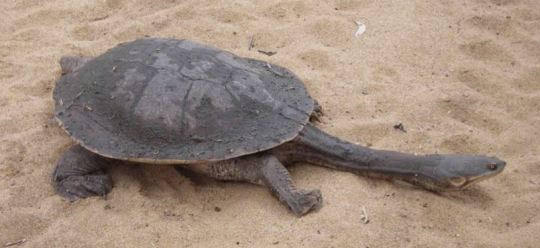
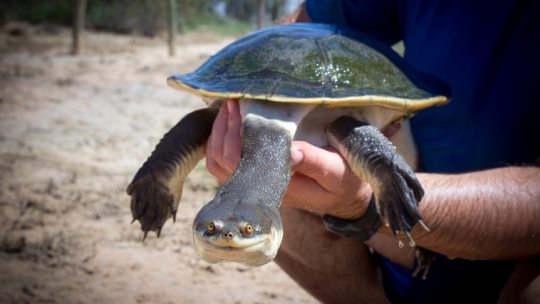

Abroad with the Broad Shelled Turtle
Chelodina expansa, more commonly known as the broad shelled turtle, is one of the largest freshwater turtles in Australia. The length of their shells can reach up to 50 cm (19.6 in), and their neck accounts for an additional 60-80% of their total length. Because of this length, C. expansa tucks its head in sideways as opposed to pulling it directly into its shell. At maximum, females reach a mass of 6 kg (13.2 lbs), while males only typically weigh about 4 kg (8.8 lbs). The top of the shell, or carapace, is dark brown or green, while the underside is a light cream; the same is true for the broad shelled turtle's head, neck, and legs. The feet are webbed, and have large claws which help adults to dig or fend off predators.
While they spend the winter buried in the mud, the broad shelled turtle is most active during the summer months, from November to March. During this time they are almost entirely aquatic, rarely emerging from the water even to bask. This species lives throughout the river basins of eastern Australia, and can be found in rivers, dams, lakes, and wetlands with plenty of vegetation cover. C. expansa is entirely carnivorous, feeding on crustaceans, aquatic insects, fish, and frogs via ambush, and carrion whenever it can find it. To locate prey, they have a keen sense of smell. Adults are not usually predated upon due to their thick shells and sharp claws, but eggs and juveniles are often prey for foxes, dingos, birds, rakalai, and large fish.
C. expansa nests in the winter, beginning in late February or March. Outside the mating season, individuals are generally solitary, but aggressive territoriality has not been observed. When mating time roles around, males seek out females to mate with; following the encounter, the female climbs out onto the bank and digs a nest for a clutch of anywhere from 5 to 28 eggs. To seal the nest, she then slams her body into the re-piled sand and mud, compacting it into a plug that will remain intact until the following year.
Incubation takes about 360 days, though some nests have been recorded as hatching at 500 days; this process is exceptionally slow due to the two periods of diapause, or developmental delays, that embryos pass through in order to survive the winter. Juveniles hatch in the spring, and emerge from the nest at the first heavy rain. It's unknown how long these turtles can live in the wild, but given their slow growth rate and adult invulnerability it's likely that they can live in excess of 20 years.
Conservation status: The IUCN consideres the broad shelled turtle to be Near Threatened, due primarily to habitat loss and high rates of nest predation by introduced foxes.
If you like what I do, consider leaving a tip or buying me a kofi!
Photos
Claire Treilibs
Catherine Heuzenroeder
Shanna Bignell via iNaturalist
#broad shelled turtle#Testudines#Chelidae#snake-necked turtles#Austro-South American side-neck turtles#side-neck turtles#turtles#reptiles#freshwater reptiles#river reptiles#lake reptiles#wetland reptiles#Oceania#Australia#East Australia
252 notes
·
View notes
Text

east coast woes (one day apart)
#my art#oily tag#australia east coast btw though i suppose its applicable everywhere#on account of the horrors
3K notes
·
View notes
Text

A family camping in East Alligator River
Kakadu National Park
1977
#vintage camping#campfire light#australia#kakadu national park#east alligator river#family camping#camping#history#1970s
129 notes
·
View notes
Text

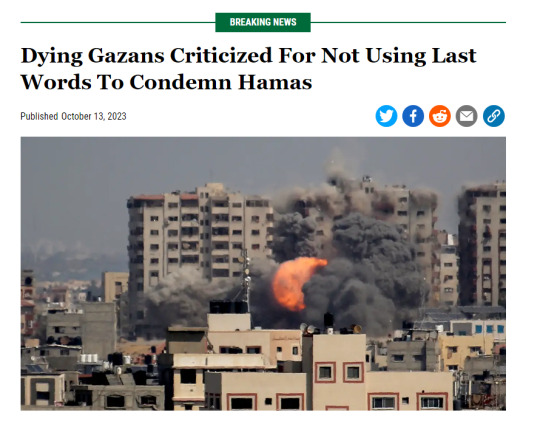
#Journalism#gaza#free palestine#the onion#democrats#republicans#middle east#gop#usa#gazans#south afica#australia
64 notes
·
View notes
Text
When you have the chance, maybe say a prayer for the Australian independent bishop who was stabbed earlier today, along with his attacker.
May Jacques Hamel and Thomas Becket pray as well.
45 notes
·
View notes
Text

Bridget Costello in her 3 different Christine wigs
(West End, Australia, Riyadh)
Pictures: Bridget Costello instagram
#phantom of the opera#phantomoftheopera#bridget costello#bridget mary costello#poto london#poto west end#poto australia revival#poto australia tour#poto australian tour#poto Sydney#poto melbourne#poto middle east tour#poto Middle Eastern tour#poto Riyadh
68 notes
·
View notes
Text
interact with this post in some way for me to randomly* assign you a country, territory, autonomous zone, or other region to research and follow current events for in 2024
Some clarifications before we get started
I'm using a random list generator to come up with these assignments so micronations won't be included
Everyone SHOULD be learning what they can about the genocide being inflicted against Palestinians and the Israel vs Palestine conflict more broadly, so for that reason I want everyone to treat Palestine as another country to learn more about in addition to the one I assign
interacting with this post in any way will be treated as an invitation to given you an assignment, this includes interacting exclusively to tell me NOT to do so
There's no set deadlines for turning anything in; if you wanna send new findings each week you're welcome to do that but you can also submit them monthly or even compile them to release at the end of 2024
Multiple interactions via the same blog won't lead to multiple assignments unless you explicitly ask for more
While I'm not going to explicitly require or forbid you to use specific sources I'd encourage you to look at sources both from within your assigned nation as well as from those outside of it, and in general be aware of fact checking and whatnot
*and some clarification: this won't be entirely at random because I'm going to generally try to avoid assigning anybody their own country...but like if you don't have it in your bio I'm not gonna ask what it is I'll just not worry about it when giving you your assignment
#nations of the world tournament#free palestine#tournament host#Can't tag all the places#North America#South America#Asia#Europe#Central America#the middle east#Africa#Oceania#Australia#Antarctica#Scandinavia#The baltics#The Balkans#The nordics#South asia#East asia#I at least tried to get a good mix of regions tagged
15 notes
·
View notes
Text
Time for baby
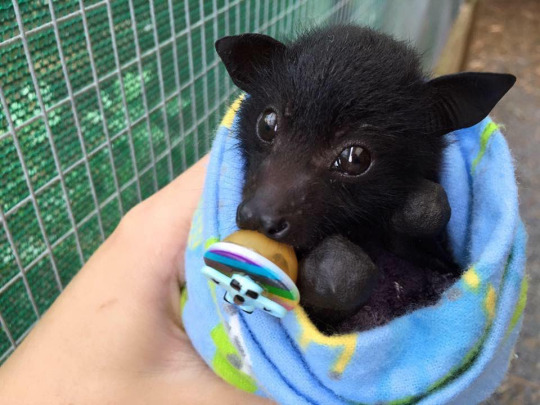
#Black Flying fox#Bats of Australia#bats of South east Asia#bat of the day#daily bat#bat#bats#batposting#cute bats#cute animals#literal baby#look at them#such a cute bat#you love to see
231 notes
·
View notes
Text
Every time I complain about the heat my dad says "it might be early onset menopause"
11 notes
·
View notes
Photo

Conondale National Park, Queensland, Australia
#Tropical#jungle#rainforest#Australia#nature#ferns#Tropics#forest#mountains#rivers#south-east Queensland#Gold Coast hinterlands#Queensland#palms
162 notes
·
View notes
Text

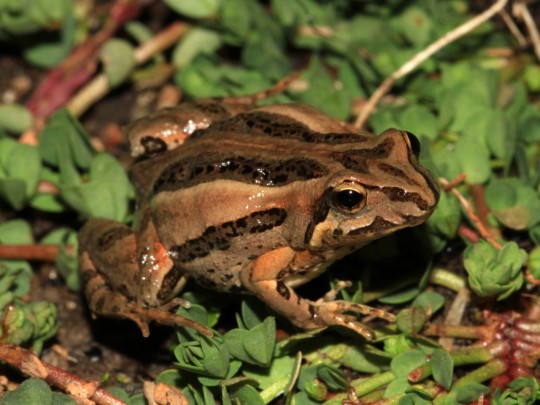
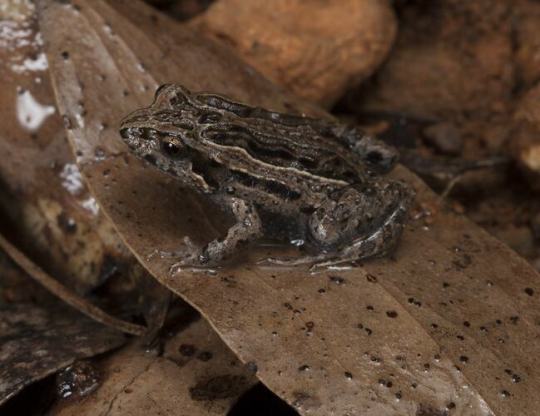

Commune with the Common Eastern Froglet
The common eastern froglet (Crinia signifera) is, as its name suggest, a widely encountered species of frog in eastern Australia, as well as the island of Tasmania. This species can be found in many habitats, including deciduous eucalyptus forests, wetlands, and agricultural and urban ponds and dams. During the dry season, froglets will also shelter under logs or leaf litter to prevent desiccation.
C. signifera is one of the smallest species of frog, reaching only 3 cm (1.2 in) in length. Most individuals are brown, but specific markings can vary widely from region to region; some have dark stripes while others take on a more mottled appearance, though generally the belly is lighter than the back and head. Because this species is largely terrestrial, they lack webbing on their toes.
Like most frogs, the common eastern froglet consumes primarily insects, especially mosqitoes, cockroaches, flies, and small spiders. In turn, the species is food for a wide variety of predators including larger frogs, fish, birds, and small rodents. Because C. signifera is active all year round, its distinctive cricket-like "Crick crick" call can be heard in every season, typically as males attempt to attract a mate, though their coloration and small size makes them difficult to find.
Under ideal conditions, C. signifera mates througout the year. Once a male has attracted a female, typically by being the loudest male in an area, he will climb on top of an inseminate her in a common position known as amplexus. Afterwards, the female will lay upwards of 200 eggs attatched to a leaf or stick at the water's surface level. Though these eggs are a popular snack for predators, it only takes about 10 days for them to hatch; afterwards, hundreds of tadpoles will occupy the water for anywhere from 6 weeks to 3 months. Fully mature adults leave the water to find food and mates, but will often stay close to their original breeding ground.
Conservation status: The IUCN considers the common eastern froglet to be of Least Concern. Though the species is threatened by habitat loss, it is remarkably resilient to the chytrid fungus which has devestated so many other Anuran species.
If you like what I do, consider leaving a tip or buying me a ko-fi!
Photos
Stephen Mahony
Matt Clancy
David Paul
George Vaugan
#common eastern froglet#Anura#Myobatrachidae#froglets#Australian ground frogs#frogs#amphibians#deciduous forests#deciduous forest amphibians#wetlands#wetland amphibians#urban fauna#urban amphibians#oceania#australia#east australia#biology#zoology#animal facts
105 notes
·
View notes
Text
I’ve come to notice something about most internet discussions regarding societal norms and cultural differences
when someone mentions “the east”, they’re probably exclusively referring to Asia, but not Russia, Central Asia, the Middle East, or certain parts of South Asia
when someone mentions “the west”, they’re exclusively referring to the white populations of the USA, UK, Australia, and sometimes Canada
you’ll rarely find someone actually including Eastern Europeans or any minorities not mentioned above to be included unless they themselves are part of that group
its kinda weird
#internet#discourse#western society#eastern society#middle east#asian#africa#north america#australia#oceania#south america#latin america#europe#eastern europe#usa
12 notes
·
View notes
Text
The US leg ending on the west coast is just prep for when shows go international and my streaming days will be over
#like what happens when she’s in Europe and the show starts at 2 pm my time#or Australia or Singapore#rip east coast shows you’re missed
36 notes
·
View notes
Photo

“ Happiness, not something you can buy. It’s a choice you can make every day. “
// Josh Burkinshaw
145 notes
·
View notes
Text

#zionistterror#zionistcensorship#zionists#white zionists#indigenous#middle east#ancestral lands#amy schumer#antizionist#antifa#antifascist#antifaschistische aktion#antifascismo#antifaschismus#ausgov#politas#auspol#tasgov#taspol#australia#fuck neoliberals#neoliberal capitalism#anthony albanese#albanese government#antinazis#antinazi#antiauthoritarian#anarchism#anarchist#anarchocommunism
5 notes
·
View notes
Text
I was going to let this go, but I can't stand it anymore.
What is UP with Evilive and Australia???
(This is a joke btw and not at all serious I love this show)

Okay, so I haven't heard of an 'E2' class Australian visa. No big deal. But it made me curious as to what it was, so I briefly looked for information on what visas Australia had in 2008 and...I couldn't find anything referencing an E2 visa for someone emigrating from South Korea to Australia. What I can find is an E2 class visa for someone emigrating from Australia to South Korea. I can also find an E2 visa for someone emigrating to the US.
So: 1. I'm dumb and missed something. 2. The writers were familiar with E2 visas because South Korea has them, and the US has them, so like...who would notice?
(Side note: They are emigrating to Sydney!!! Whoo NSW representation!!!)
But this...this was what broke me:


???
??????
Okay. So, you're exporting to...Sydney? Maybe? Sure, lets go with that because literally nothing else makes sense (except Newcastle??? Which has a major port, apparently). And then bypassing Brisbane to ship to...Gladstone, Queensland? Okay, sure. I googled it and they seem to...export a lot of stuff, and have a major port there, so maybe they import too?
And then...what.
Where even IS that in WA (Western Australia)???
Oh! I looked it up and it's most likely Port Hedland, which is apparently another major port! The largest bulk...export...port in the world, supposedly. But maybe they import as well? (Okay, so it DOES import, but wow the difference between the import and export numbers is...a lot. Wikipedia even has 2008 statistics. Neat!)
Wow, the attention to detail sure is great in this show, but...uh...
Why???? Coal????
Why are you shipping our major export, that we export to you, our #3 export market in 2008...back to us?????
Like...it's just about the only thing we do. We export coal. I learned about our coal industry in school. Our richest person is a billonaire mining magnate. One of our former Prime Ministers became a joke for saying, "Coal is good for humanity." And then my university lecturer for Environmental Law got so pissed she put the quote in our final exam as an essay question.
But I digress.
I still looked it up to see if we import coal and export it, and the answer is...no. We do not.
LNG and ORE are also unlikely, as they're some of our other major exports (well, Iron Ore is). I can't find a lot of data from 2008 specifically, but the 2016-2019 data isn't good (compare imports on pages 52-53 with exports pages 54-56) and it seems recently (2021-2022) our major imports from South Korea included refined petroleum and cars. Not Ore and LNG. However, despite being the #1 exporter in the world for Iron Ore in 2021, we were the #42 importer of it too, so that one's possible imo. LNG though? Not as likely as ORE, because we export it and seem to supply it domestically, but way more likely than Coal.
Conclusion?
For a scene that barely lasts 2 seconds, the level of detail is crazy. I'm genuinely very impressed.
Also. It is hilarious that Seo Do Young was planning to sell us coal. The end.
#evilive#evillive#biography of a villain#PS it's VEEEERY funny that Han Dong Soo's arsonist mother#was going to come to Australia of all places#bushfire nation of the world#AND IN 2008#like my guy you should be soooo glad you stayed in South Korea actually#PPS I couldn't figure out was 'WA US' and 'EA US' meant#and I JUST realised it means 'West Australia' and 'East Australia'#West Australia and East Australia and GLADSTONE#I'm deceased
9 notes
·
View notes